CHEVROLET MONTE CARLO 1996 5.G Repair Manual
Manufacturer: CHEVROLET, Model Year: 1996, Model line: MONTE CARLO, Model: CHEVROLET MONTE CARLO 1996 5.GPages: 340, PDF Size: 17.79 MB
Page 61 of 340
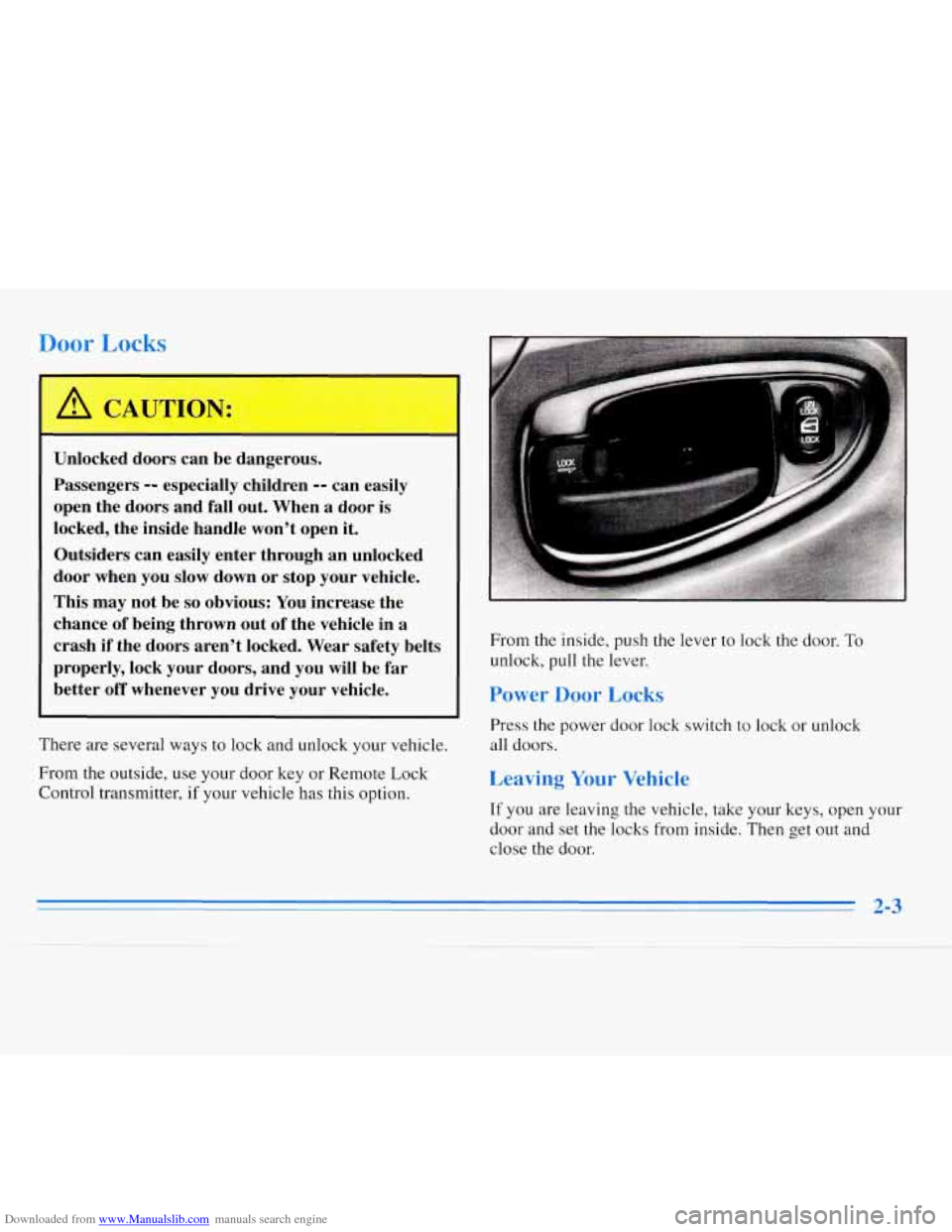
Downloaded from www.Manualslib.com manuals search engine Door Locks
I I
Unlocked doors can be dangerous.
Passengers
-- especially children -- can easily
open the doors and fall out. When a door is
locked, the inside handle won’t open it.
Outsiders can easily enter through an unlocked
door when you slow down or stop your vehicle.
This may not be
so obvious: You increase the
chance of being thrown out
of the vehicle in a
crash if the doors aren’t locked. Wear safety belts
properly, lock your doors, and you will be far
better
off whenever you drive your vehicle.
There are several ways to lock and unlock your vehicle.
From the outside, use your door key or Remote Lock
Control transmitter, if your vehicle has this option. From the inside,
push the lever
to lock the door. To
unlock, pull the lever.
Power Door Locks
Press the power door lock switch to lock or unlock
all doors.
Leaving Your Vehicle
If you are leaving the vehicle, take your keys, open your
door and set the locks from inside. Then get out and
close the door.
2-3
Page 62 of 340
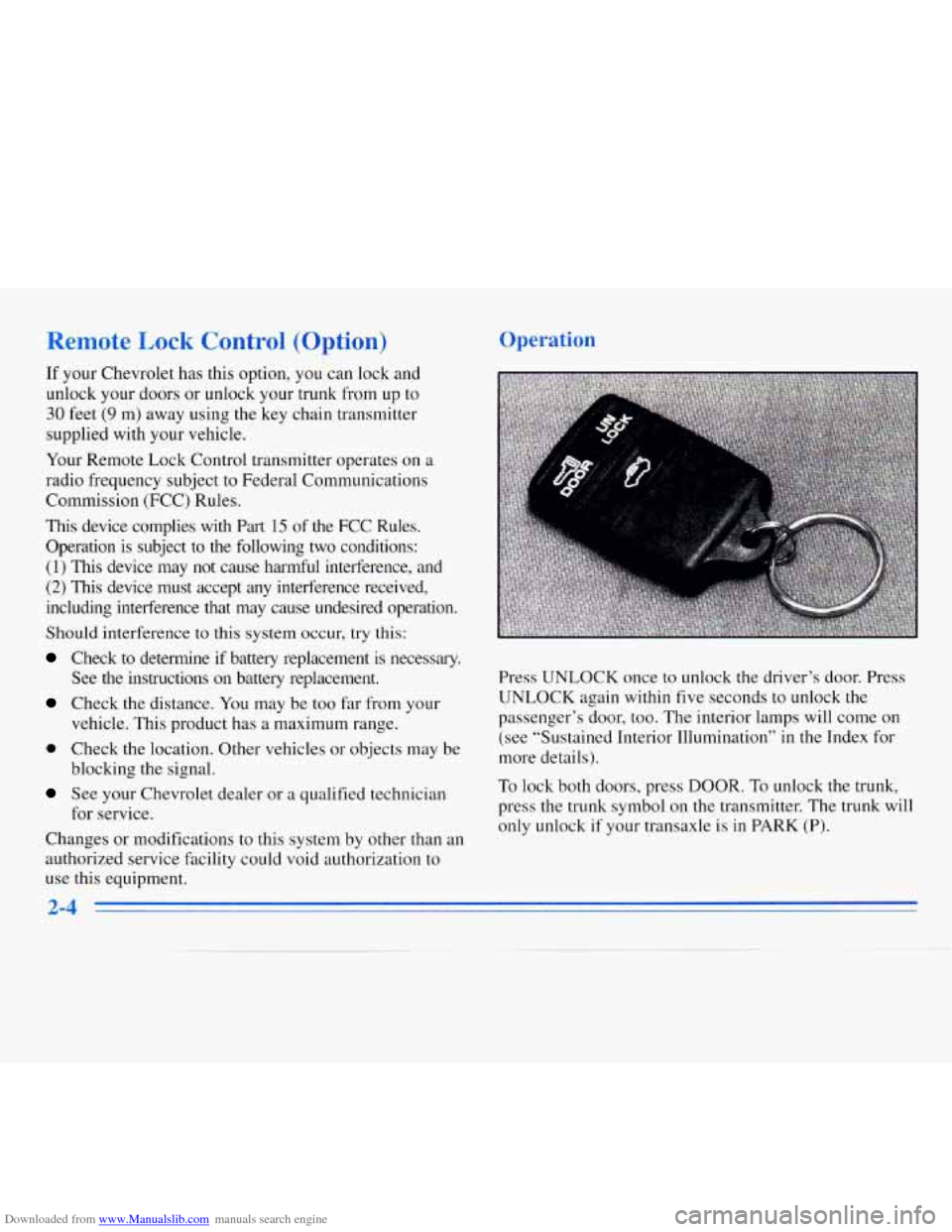
Downloaded from www.Manualslib.com manuals search engine IT your Chevrolet has this option, you can lock and
unlock your doors or unlock your trunk from up to
30 feet (9 m) away using the key chain transmitter
supplied with your vehicle.
Your Remote Lock Control transmitter operates on
a
radio frequency subject to Federal Communications
Commission (FCC) Rules.
This device complies with
Part 15 of the FCC Rules.
Operation is subject to the following two conditions:
(1) This device may not cause harmful interference, and
(2) This device must accept any interference received,
including interference that may cause undesired operation.
Should interference to this system occur, try this:
Check to determine if battery replacement is necessq.
See the instructions on battery replacement.
Check the distance. You may be too far from your
0 Check the location. Other vehicles or objects may be
See your Chevrolet dealer or a qualified technician
Changes or modifications to this system by other than an
authorized service facility could void authorization to
use this equipment.
vehicle.
This product has
a maximum range.
blocking the signal. for service. Press
UNLOCK once to unlock the driver’s door. Press
UNLOCK again within five seconds to unlock the
passenger’s door, too. The interior lamps will come on
(see “Sustained Interior Illumination” in the Index for
more details).
To lock both doors, press DOOR. To unlock the trunk,
press the trunk symbol on the transmitter. The trunk will
only unlock
if your transaxle is in PARK (P).
Page 63 of 340
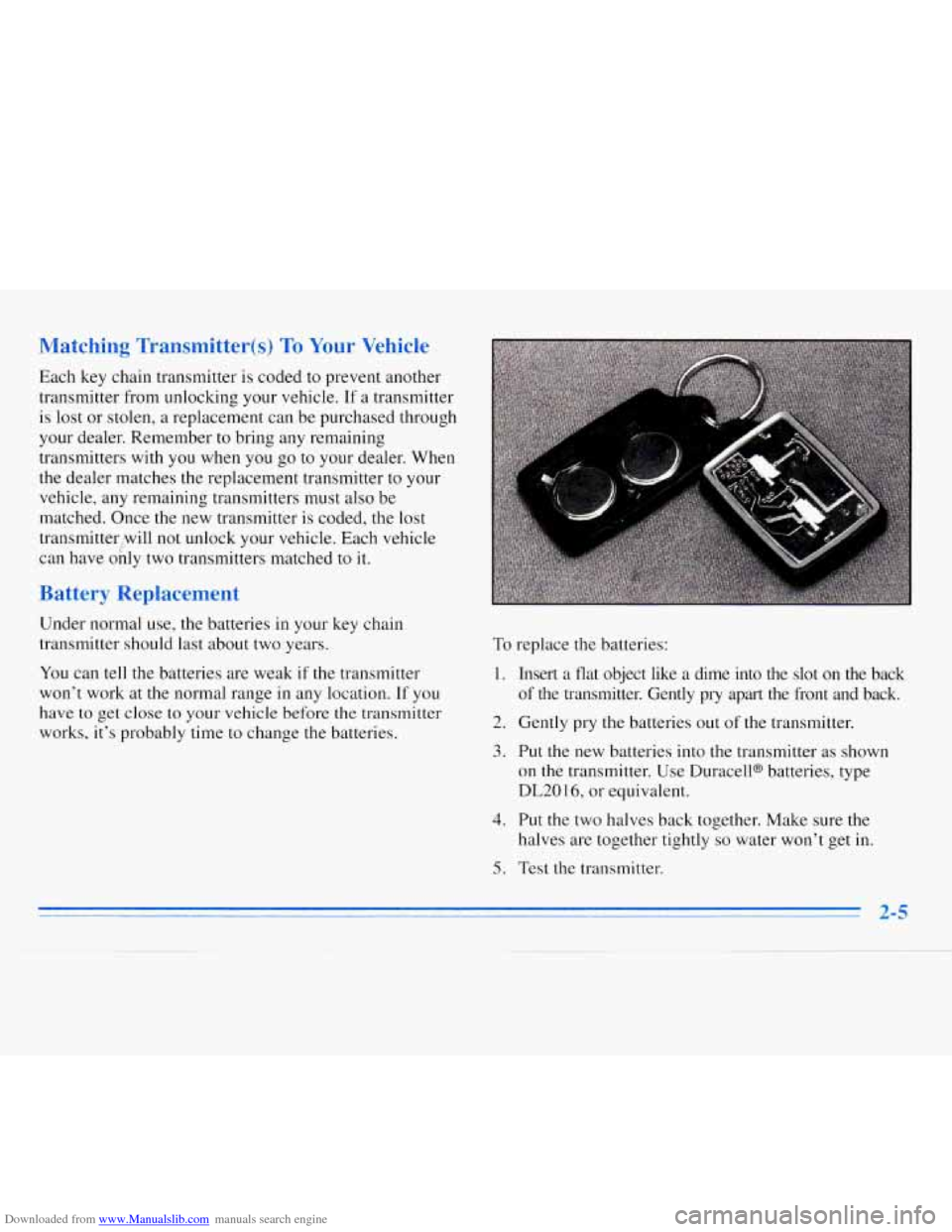
Downloaded from www.Manualslib.com manuals search engine Matching Transmitter(s) To Your Vehicle
Each key chain transmitter is coded to prevent another
transmitter from unlocking your vehicle. If
a transmitter
is lost or stolen,
a replacement can be purchased through
your dealer. Remember to bring any remaining
transmitters with
you when you go to your dealer. When
the dealer matches the replacement transmitter to your
vehicle, any remaining transmitters must
also be
matched. Once the new transmitter
is coded, the lost
transmitter,will not unlock your vehicle. Each vehicle
can have only two transmitters matched to
it.
Battery Replacement
Under normal use, the batteries in your key chaill
transmitter should last about two years.
You can tell the batteries are weak if the transmitter
won’t work at
the normal range in any location. If you
have
to get close to your vehicle before the transmitter
works, it’s probably time
to change the batteries.
To replace the batteries:
1. Insert a flat object like a dime into the slot on the back
of the transmitter. Gently pry apart the front and back.
2. Gently pry the batteries out of the transmitter.
3. Put the new batteries into the transmitter as shown
on the transmitter. Use DuracelP batteries, type
DL20 16, or equivalent.
4. Put the two halves back together. Make sure the
halves are together tightly
so water won’t get in.
5. Test the transmitter.
2-5
Page 64 of 340
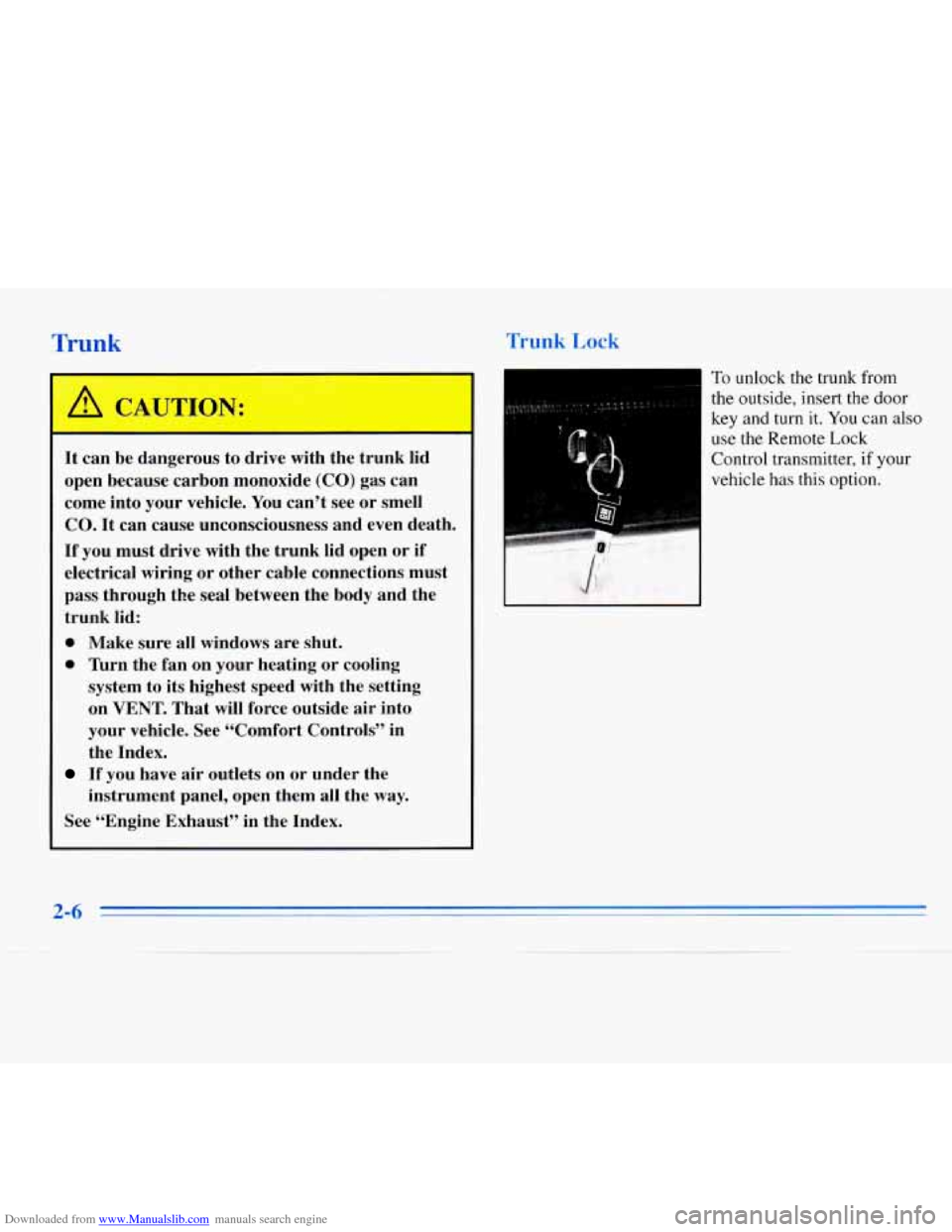
Downloaded from www.Manualslib.com manuals search engine Trunk Trunk Lock
It can be dangerous to drive with the trunk lid
open because carbon monoxide (CO) gas can
come into your vehicle. You can't see or smell
CO. It can cause unconsciousness and even death.
If you must drive with the trunk lid open or if
electrical wiring
or other cable connections must
pass through the seal between the body and the
trunk lid:
~ 0 Make sure all windows are shut.
0 Turn the fan on your heating or cooling
system to its highest speed with the setting
on VENT. That will force outside air into
your vehicle. See "Comfort Controls'' in
the Index.
instrument panel, open them all the way.
If you have air outlets on or under the
See "Engine Exhaust" in the Index.
To unlock the trunk from
the outside, insert the door
key and turn it.
You can also
use the Remote Lock
Control transmitter,
if your
vehicle has this option.
2-6
Page 65 of 340
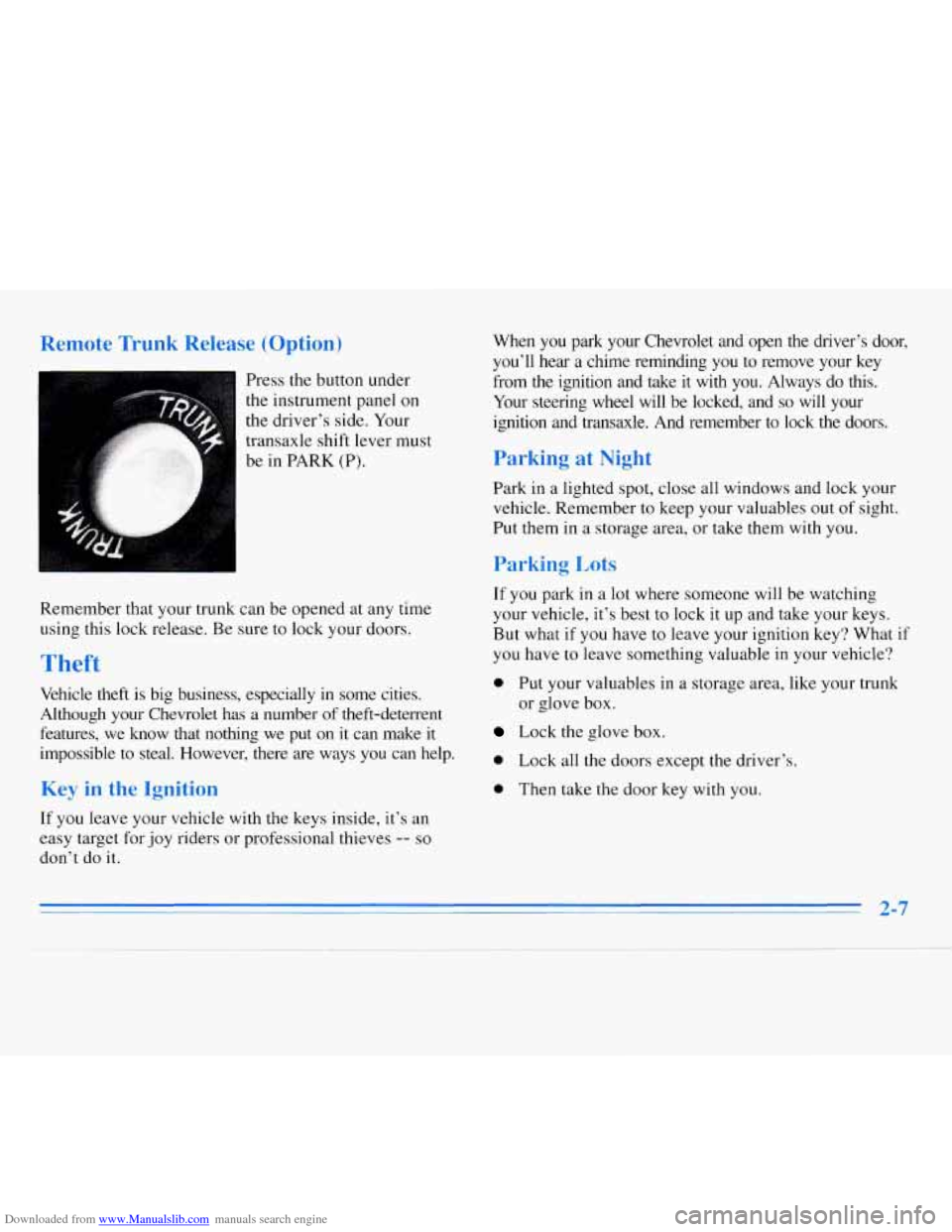
Downloaded from www.Manualslib.com manuals search engine Remote Trunk Release (Option)
Press the button under
the instrument panel
on
the driver’s side. Your
transaxle shift lever must
be in PARK
(P).
Remember that your trunk can be opened at any time
using this lock release. Be sure to lock your doors.
Theft
Vehicle theft is big business, especially in some cities.
Although your Chevrolet has a number
of theft-deterrent
features, we know that nothing we put on it can make
it
impossible to steal. However, there are ways you can help.
Key in the Ignition
If you leave your vehicle with the keys inside, it’s an
easy target for joy riders or professional thieves
-- so
don’t do it. When
you park your Chevrolet and open the driver’s door,
you’ll hear
a chime reminding you to remove your key
from the ignition and take it with you. Always do this.
Your steering wheel will be locked, and
so will your
ignition and transaxle. And remember to lock the doors.
Parking at Night
Park in a lighted spot, close all windows and lock your
vehicle. Remember
to keep your valuables out of sight.
Put them in a storage area, or take them with you.
Parking Lots
Tf you park in a lot where someone will be watching
your vehicle, it’s best
to lock it up and take your keys.
But what if
you have to leave your ignition key? What if
you have to leave something valuable in your vehicle?
0 Put your valuables in a storage area, like your trunk
Lock the glove box.
or glove box.
0 Lock all the doors except the driver’s.
0 Then take the door key with you.
Page 66 of 340
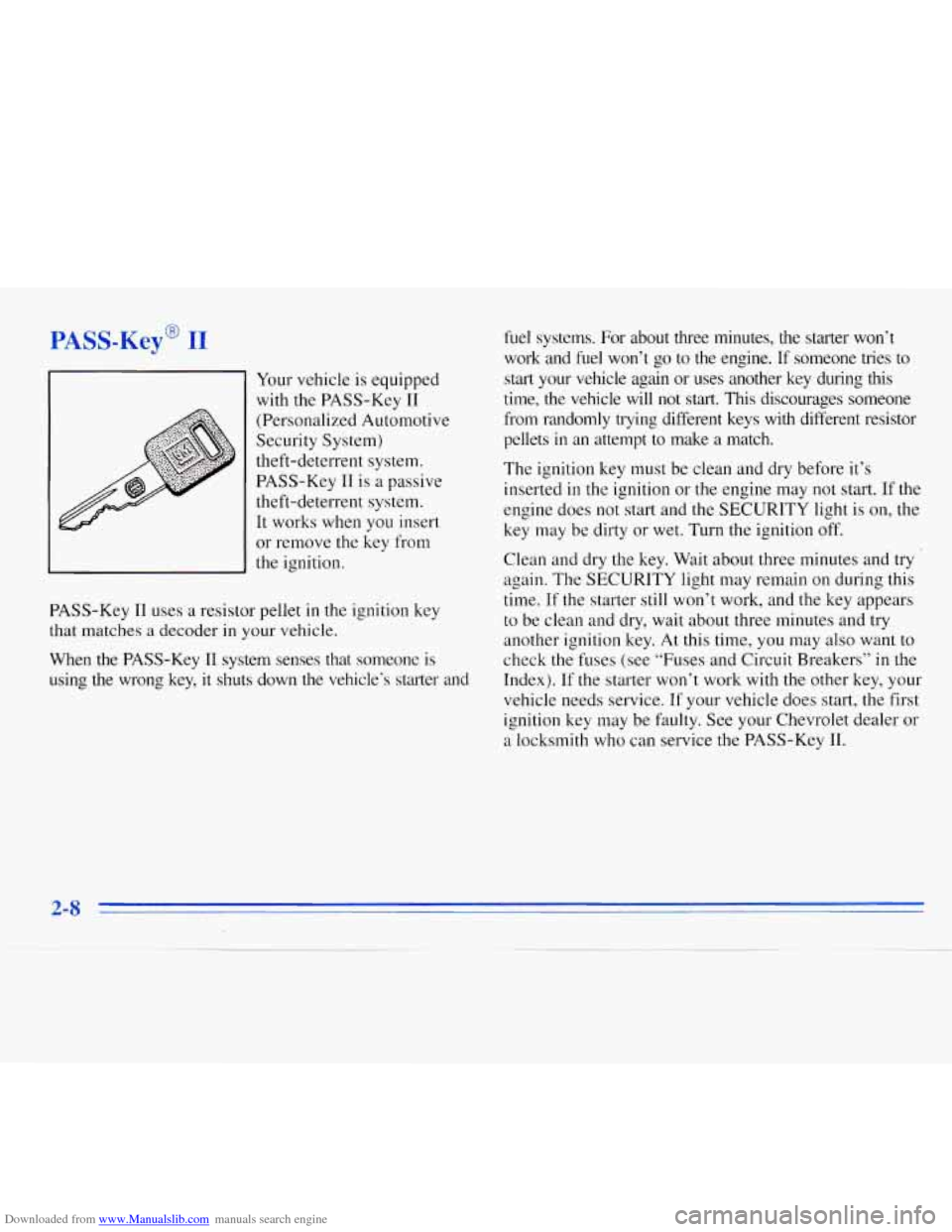
Downloaded from www.Manualslib.com manuals search engine PASS-Key@ II
Your vehicle is equipped
with the PASS-Key I1
(Personalized Automotive
Security System)
theft-deterrent system.
PASS-Key IT is
a passive
theft-deterrent system.
It works when you insert
or remove the key from
the ignition.
PASS-Key I1 uses
a resistor pellet in the ignition key
that matches
a decoder in your vehicle.
When the PASS-Key
TI system senses that sonleone is
using the wrong key,
it shuts down the vehicle’s starter and fuel systems. For about three minutes, the starter
won’t
work and fuel won’t go to the engine.
If someone tries to
start your vehicle again or uses another key during this
time, the vehicle will not stcart. This discourages someone
from randomly trying different keys with different resistor
pellets
in an attempt to make a match.
The ignition key must be clean and dry before it’s
inserted
in the ignition or the engine may not start. If the
engine does not start and the SECURITY light is on, the
key may be dirty or wet. Turn the ignition off.
Clean and dry
the key. Wait about three minutes and try
again. The SECURITY light may remain on during this
time. If the starter still won’t work, and the key appears
to be clean and dry, wait about three minutes and try
another ignition
key. At this time, you may also want to
check the fuses (see “Fuses and Circuit Breakers”
in the
Index). If the starter won’t work with the other key, your
vehicle needs service. If your vehicle does start, the first
ignition key may be faulty. See your Chevrolet dealer or
a locksmith who can service the PASS-Key 11.
2-8
Page 67 of 340
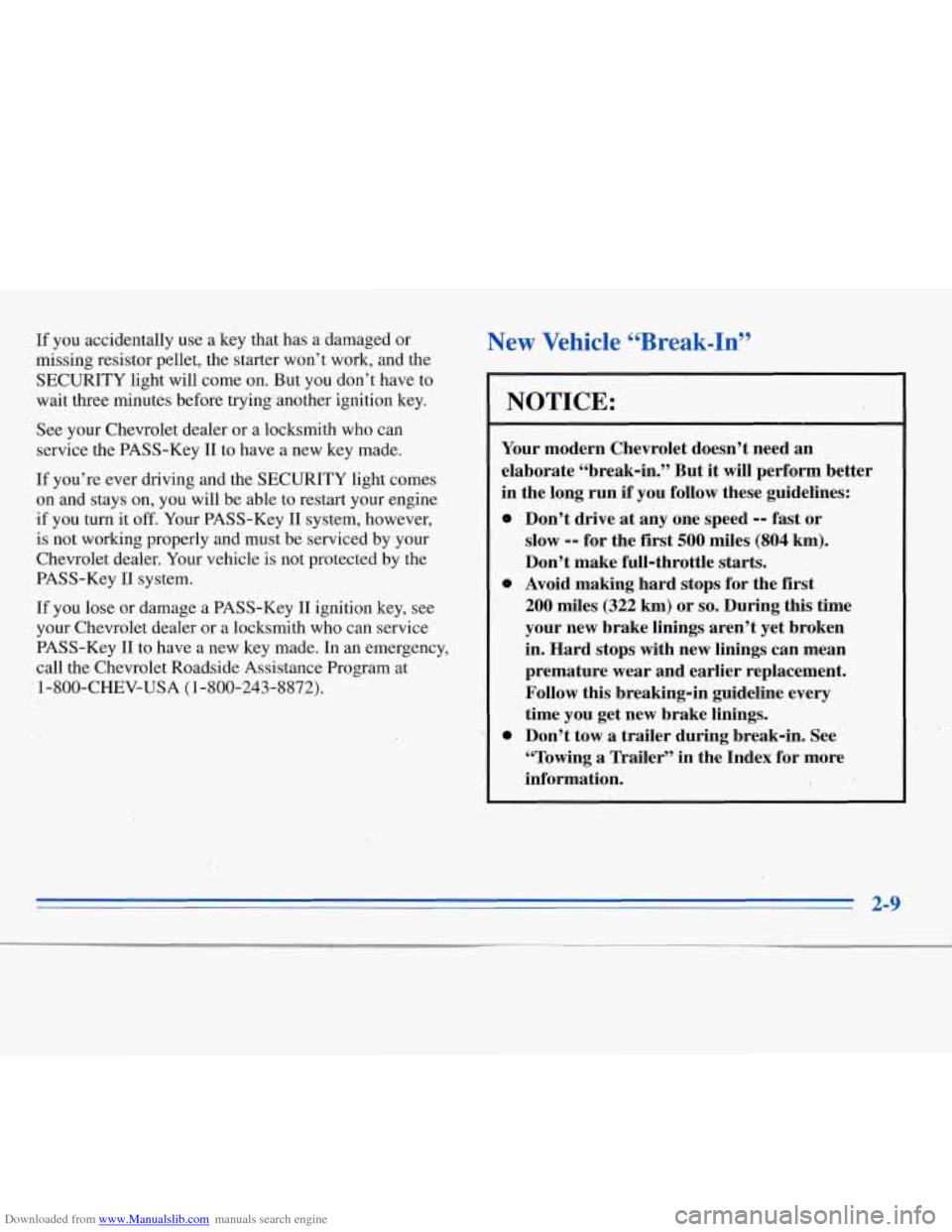
Downloaded from www.Manualslib.com manuals search engine If you accidentally use a key that has a damaged or
missing resistor pellet, the starter won’t work, and the
SECURITY light will come on. But you don’t have to
wait three minutes before trying another ignition key.
See your Chevrolet dealer or a locksmith who can
service the PASS-Key I1 to have a new key made.
If you’re ever driving and the SECURITY light comes
on and stays on, you will be able to restart your engine
if you turn it off. Your PASS-Key I1 system, however,
is not working properly and must be serviced by your
Chevrolet dealer. Your vehicle is not protected by the
PASS-Key
II system.
If you lose or damage
a PASS-Key I1 ignition key, see
your Chevrolet dealer or a locksmith who can service
PASS-Key I1 to have a new key made. In an emergency,
call the Chevrolet Roadside Assistance Program at
1-800-CHEV-USA
(1-800-243-8872).
New Vehicle “Break-In”
NOTICE:
Your modern Chevrolet doesn’t need an
elaborate “break-in.” But
it will perform better
in the long run if you follow these guidelines:
0 Don’t drive at any one speed -- fast or
slow
-- for the first 500 miles (804 km).
Don’t make full-throttle starts.
200 miles (322 km) or so. During this time
your new brake linings aren’t yet broken
in. Hard stops with new linings can mean
premature wear and earlier replacement.
Follow this breaking-in guideline every
time
you get new brake linings.
0 Don’t tow a trailer during break-in. See
“Tdwing
a Trailer” in the Index for more
information.
I
0 Avoid making: hard stops for the first
I 2-9 1
Page 68 of 340
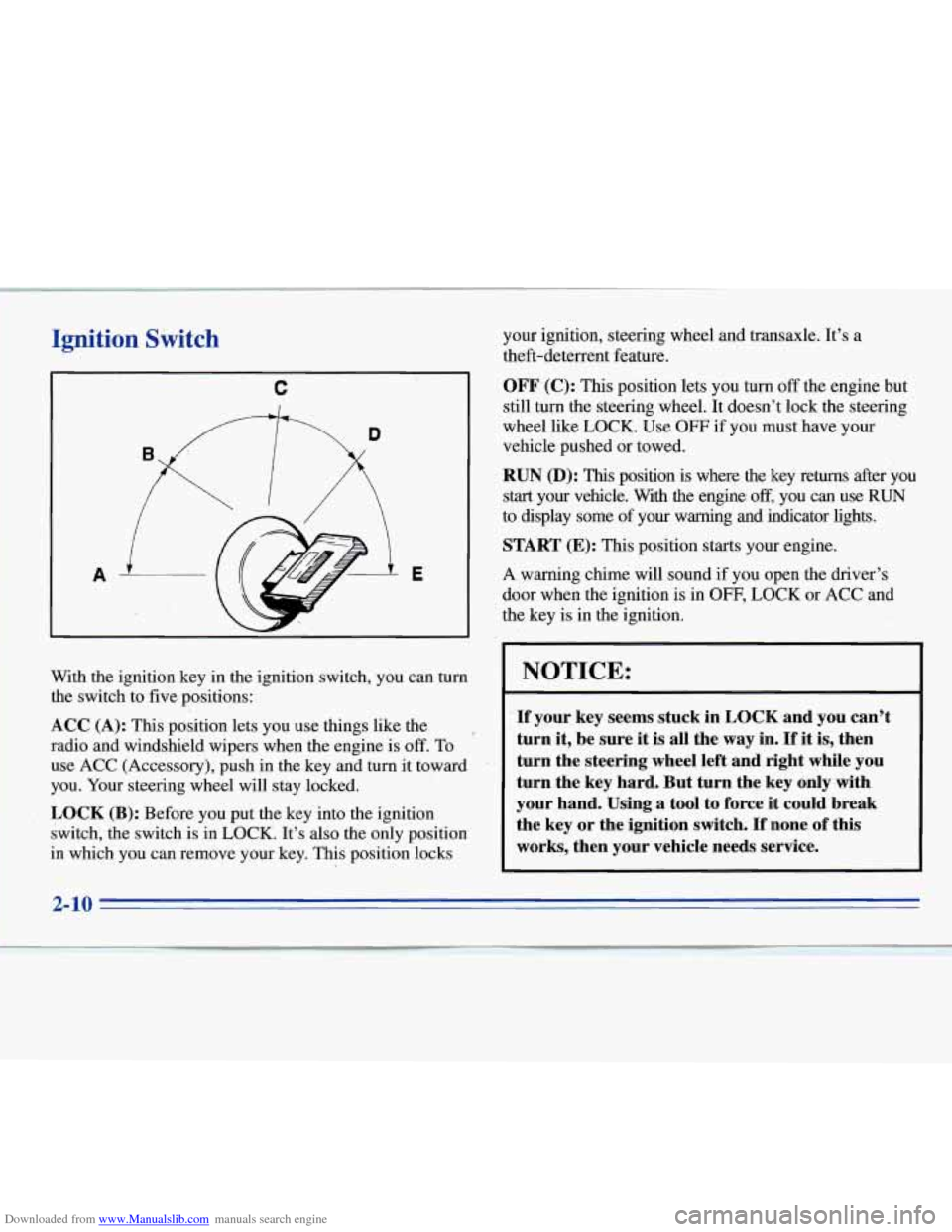
Downloaded from www.Manualslib.com manuals search engine Ignition Switch
C
With the ignition key in the ignition switch, you can turn
the switch to
five positions:
ACC (A): This position lets you use things like the
radio and windshield wipers when the engine is off. To
use ACC (Accessory), push in the key and turn it toward
you. Your steering wheel will stay locked.
LOCK-(B): Before you put the key into the ignition
switch, the switch is in LOCK. It’s also the only position
in which you can remove your key. This position locks your
ignition, steering wheel and transaxle. It’s a
theft-deterrent feature.
OF” (C): This position lets you turn off the engine but
still turn the steering .wheel. It doesn’t lock the steering
wheel like LOCK. Use
OFF if you must have your
vehicle pushed
or towed.
RUN (D): This position is where the key returns after you
start your vehicle. With the engine off, you can use RUN
to display some of your warning and indicator lights.
START (E): This position starts your engine.
A warning chime will sound if you open the driver’s
door when the ignition is in
OFF, LOCK or ACC and
the key is in the ignition.
NOTICE:
If your key seems stuck in LOCK and you can’t
turn
it, be sure it is all the way in. If it is, then
turn the steering wheel left and right while you
turn the key hard. But turn the key only with
your hand. Using
a tool to force it could break
the key or the ignition switch. If none
of this
works, then your vehicle needs service.
2-10
Page 69 of 340
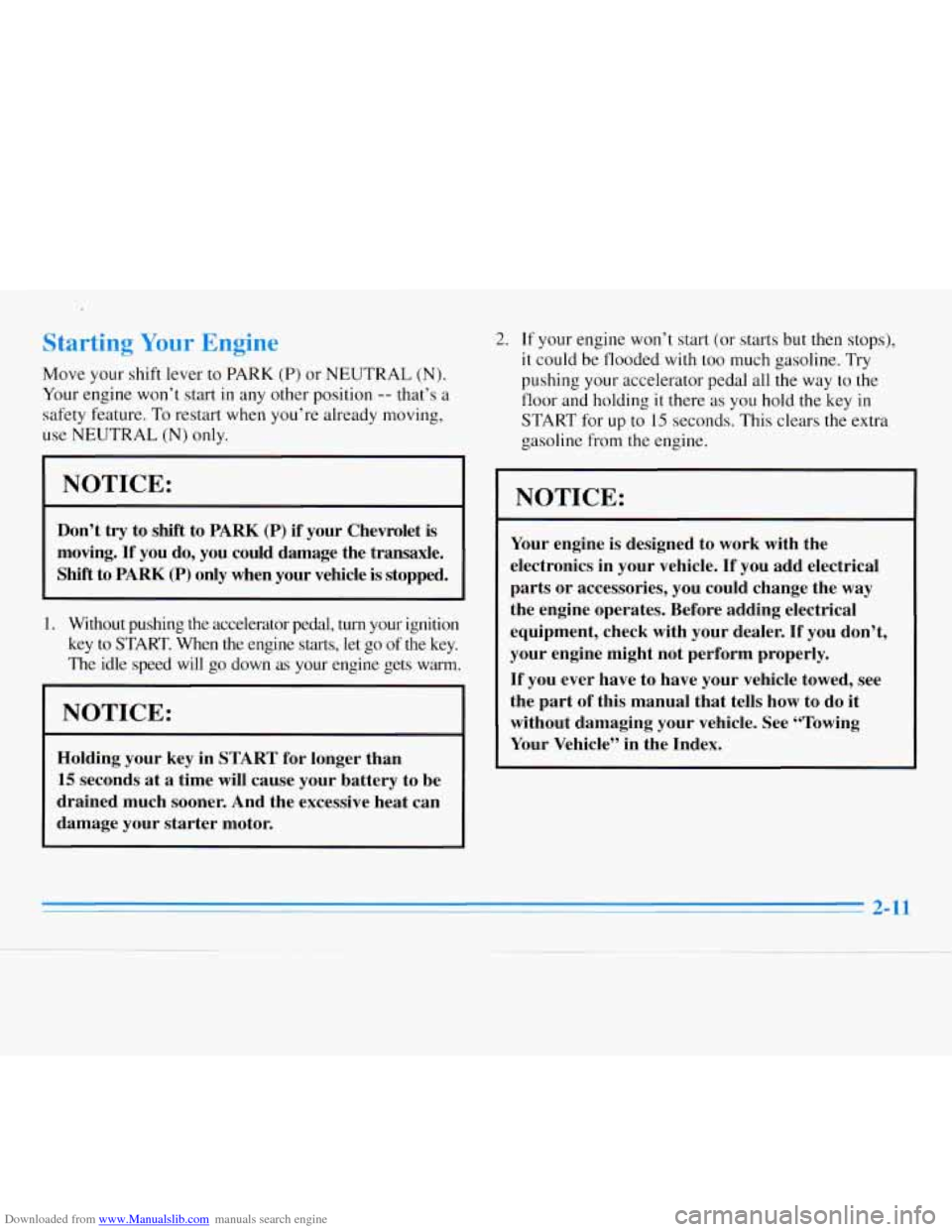
Downloaded from www.Manualslib.com manuals search engine 9L- ---- - - --- -- --- -
Move your shift lever to PARK (P) or NEUTRAL (N).
Your engine won’t start in any other position -- that’s a
safety feature. To restart when you’re already moving,
use NEUTRAL
(N) only.
2
Don’t try to shift to PARK (P) if your Chevrolet is
moving. If you do, you could damage the transaxle.
Shift to
PARK (P) only when your vehicle is stopped.
1. Without pushing the accelerator pedal, turn your ignition
key to START. When the engine
starts, let go of the key.
The idle speed will go down
as your engine gets warm.
NOTICE:
Holding your key in START for longer than
15 seconds at a time will cause your battery to be
drained much sooner. And the excessive heat can
damage your starter motor.
2. If your engine won’t start (or starts but then stops),
it could be flooded with too much gasoline. Try
pushing your accelerator pedal all the way to the
floor and holding
it there as you hold the key in
START for up to
15 seconds. This clears the extra
gasoline from the engine.
NOTICE:
Your engine is designed to work with the
electronics in your vehicle.
If you add electrical
parts or accessories, you could change the way
the engine operates. Before adding electrical
equipment, check with your dealer.
If you don’t,
your engine might not perform properly.
If you ever have to have your vehicle towed, see
the part of this manual that tells how to do it
without damaging your vehicle. See “Towing
Your Vehicle” in the Index.
Page 70 of 340

Downloaded from www.Manualslib.com manuals search engine Engine Coolant Heater (Option)
In very cold weather,
0°F (- 1 S’C) or colder,
the engine coolant
heater can help. You’ll
get easier starting and
better
fuel economy
during engine warm-up.
Usually, the coolant heater should be plugged in a
minimum of four hours prior to starting your vehicle.
To Use the Coolant Heater
1. Turn off the engine.
2. Open the hood and unwrap the electrical cord.
3. Plug it into a normal, grounded 1 10-volt AC outlet.
’ .A CAUTION:
1 - - -+* ,
Plugging the cord into an ungrounded outlet
could cause an electrical shock.
Also, the wrong
kind of extension cord could overheat and cause
a fire. You could be seriously injured. Plug the
cord into a properly grounded three-prong
110-volt
AC outlet. If the cord won’t reach,
use a heavy-duty three-prong extension cord
rated for
at least 15 amps.
4.
After you’ve used the coolant heater, be sure to store
the cord
as it was before to keep it away from moving
engine parts. If you don’t, it could be damaged.
How long should you keep the coolant heater plugged
in? The answer depends on the outside temperature, the
kind of oil you have, and some other things. Instead of
trying to
list everything here, we ask that you contact
your Chevrolet dealer in
the area where you’ll be
parking your vehicle. The dealer can give you the best
advice for that particular area.
2-12